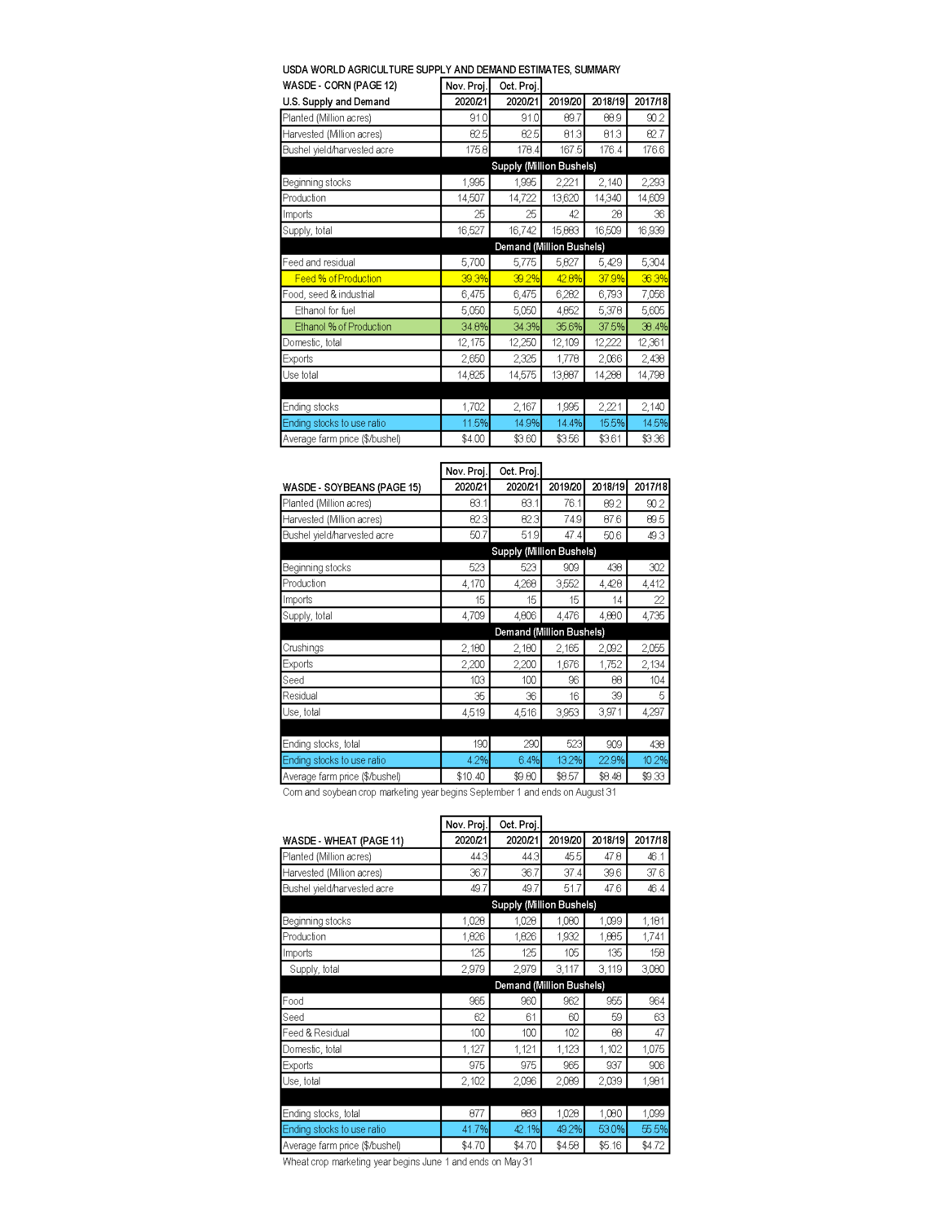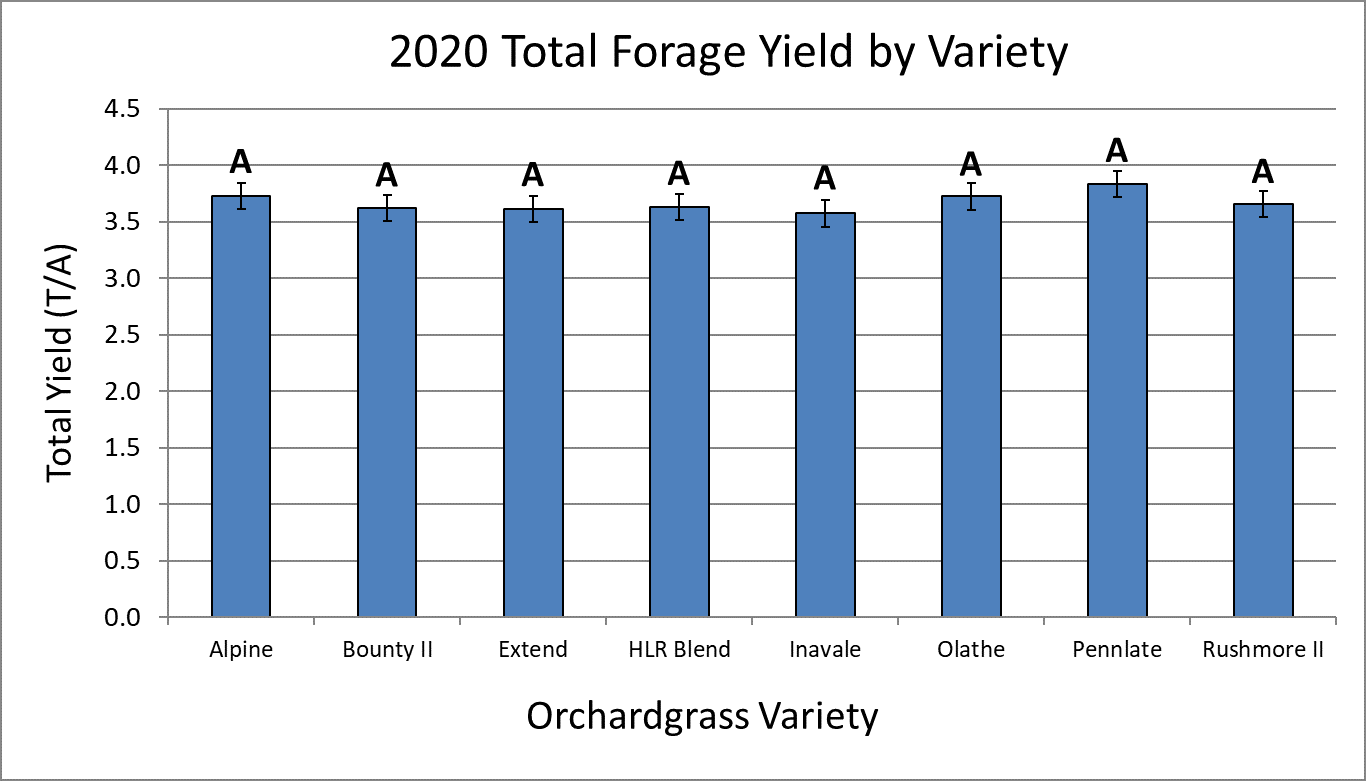Alyssa Koehler, Extension Field Crops Pathologist
University of Delaware
Carvel Research and Education Center Georgetown, DE
2020 Irrigated Corn Fungicide Trial – Rotated Field
Variety: Hubner H6187RCSS | Planting Date: 5/14/20 | Harvest Date: 9/15/20 | Planting Population: 32,000 sd/A
|
Treatmentz |
% GLS Incidence 14 daay |
% GLS Severity 14daax |
% GLS Severity 28 daa |
% GLS Severity 42 daa |
Canopeo green canopy cover
49 daa |
Moisture |
Test Weight |
Yieldw |
| Veltyma (R1)
7 oz/a |
24.0 ab |
0.24 ab |
0.48 ab |
1.10 abc |
47.2 ab |
22.8 a |
52.5 abc |
227.2 a |
| Headline AMP (R1)
10 oz/a |
22.0 ab |
0.22 ab |
0.52 bc |
1.48 d |
43.4 bc |
22.8 a |
52.7 bc |
232.3 a |
| Priaxor (R1)
4 oz/a |
24.0 ab |
0.24 ab |
0.50 ab |
1.36 bcd |
43.7 abc |
22.9 a |
52.6 bc |
227.8 a |
| USF0411 (R1)
8 oz/a |
30.0 b |
0.30 b |
0.54 b |
0.88 a |
49.8 a |
23.3 a |
52.5 abc |
228.6 a |
| Topguard EQ(R1)
5 oz/a |
22.0 ab |
0.24 ab |
0.52 ab |
1.30 bcd |
46.0 ab |
23.0 a |
52.6 bc |
229.4 a |
| Lucento (R1)
5 oz/a |
22.0 ab |
0.22 ab |
0.48 ab |
1.04 ab |
48.0 ab |
23.0 a |
52.3 ab |
231.8 a |
| Trivapro (V8) fb Miravis Neo (R1)
13.7 +13.7 oz/a |
16.0 a |
0.18 ab |
0.50 ab |
1.36 bcd |
48.3 ab |
23.6 a |
52.2 ab |
230.1 a |
| Trivapro (R1)
13.7 oz/a |
24.0 ab |
0.24 ab |
0.52 ab |
1.34 bcd |
43.7 abc |
23.1 a |
52.5 abc |
230.0 a |
| Trivapro (V8) (3 reps) 13.7 oz/a |
30.0 b |
0.30 b |
0.50 ab |
1.23 a-d |
38.8 c |
22.8 a |
52.8 c |
220.2 a |
| Miravis Neo (V8)
13.7 oz/a |
20.0 ab |
0.20 ab |
0.52 ab |
1.42 cd |
39.3 c |
22.8 a |
52.8 c |
224.8 a |
| Miravis Neo (R1)
13.7 oz/a |
14.0 a |
0.14 a |
0.46 a |
1.30 bcd |
46.2 ab |
23.3 a |
52. 1 a |
228.4 a |
| Control |
86.0 c |
0.88 c |
0.70 c |
2.50 e |
39.5 c |
22.7 a |
52.9 c |
218.1 a |
| p-value |
0.0001 |
0.0001 |
0.0001 |
0.0001 |
0.007 |
0.108 |
0.05 |
0.315 |
| LSD (α=0.05) |
12.16 |
0.13 |
0.07 |
0.36 |
6.05 |
0.57 |
0.47 |
10.75 |
z V8 applied 6/24/20, R1 applied 7/14/20 using a Co2 pressurized backpack sprayer equipped with TP8002-VS flat fan nozzle nozzles calibrated to deliver 20 GPA at 40 psi with plots set up in RCBD with five replications. All treatments included 0.125% non-ionic surfactant, Induce.
y Disease incidence was rated as percentage of 10 ear leaves with grey leaf spot lesions caused by Cercospora zeae-maydis. Means followed by the same letter are not significantly different based on Fisher’s Least Significant Difference (LSD; α=0.05).
x Grey leaf spot severity was visually assessed as the average % ear leaf covered in lesions per plot; means of 10 leaves per plot were used for analysis.
w Yield was calculated from the center two rows of each plot and adjusted to 15.5% moisture.
Warrington Irrigation Farm: 2020
Irrigated Corn Fungicide Trial – Corn on Corn
Variety: Axis 64K24 | Planting Date: 5/11/20 | Harvest Date: 10/6/20 | Planting Population: 34,000 sd/A
| Treatmentz |
Avg % GLS Incidence 14 daay |
Avg % GLS Severity 14daax |
Avg % GLS Severity
28 daa |
Avg % GLS Severity
42 daa |
Avg % Curvularia Severity
42 daaw |
Canopeo green canopy cover
42 daa |
% Lodging
72 daa |
Test Weight |
Moisture |
Yieldv |
| Veltyma (R1)
7 oz/a |
8.0 a |
0.08 a |
0.88 a |
2.28 c |
8.87 abcd |
42.4 cd |
6.0 ab |
57.0 ab |
20.26 abcd |
218.8 a |
| Headline AMP (R1)
10 oz/a |
18.0 abc |
0.18 abc |
1.00 a |
2.02 abc |
9.22 bcd |
44.0 bcd |
6.0 ab |
57.0 ab |
19.90 bcd |
228.4 a |
| Priaxor (R1)
4 oz/a |
14.0 ab |
0.14 ab |
0.98 a |
2.18 bc |
9.14 bcd |
40.9 d |
8.0 ab |
57.2 ab |
19.80 de |
220.9 a |
| Revytek (R1)
8 oz/a |
16.0 abc |
0.16 ab |
0.84 a |
1.56 abc |
7.72 a |
47.7 abcd |
2.0 ab |
56.2 c |
20.38 ab |
228.7 a |
| USF0411 (R1)
8 oz/a |
16.0 abc |
0.16 ab |
0.86 a |
1.20 a |
7.60 a |
51.8 a |
0.0 a |
56.7 bc |
20.42 a |
225.8 a |
| Delaro (R1)
8 oz/a |
14.0 ab |
0.14 ab |
0.96 a |
1.76 abc |
9.50 bcd |
41.4 d |
2.0 ab |
57.1 ab |
19.86 cde |
221.5 a |
| Topguard EQ (R1)
5 oz/a |
12.0 ab |
0.12 ab |
1.02 a |
1.82 abc |
8.40 ab |
46.8 abcd |
10.0 b |
57.0 ab |
20.16 abcd |
233.9 a |
| Lucento (R1)
5 oz/a |
20.0 bc |
0.20 bc |
0.78 a |
1.60 abc |
7.76 a |
49.2 ab |
0.0 a |
56.6 bc |
20.26 abcd |
227.0 a |
| Trivapro (R1)
13.7 oz/a |
26.0 c |
0.28 c |
0.84 a |
1.90 abc |
9.08 bcd |
46.3 abcd |
2.0 ab |
57.0 ab |
20.12 abcd |
226.7 a |
| Miravis Neo (R1)
13.7 oz/a |
12.0 ab |
0.12 ab |
0.70 a |
1.42 ab |
8.58 abc |
48.7 abc |
4.0 ab |
56.8 bc |
20.32 abc |
226.3 a |
| Quilt Xcel (R1)
10.5 oz/a |
20.0 bc |
0.20 bc |
1.08 a |
2.00 abc |
9.74 cd |
46.3 abcd |
8.0 ab |
56.8 bc |
20.22 abcd |
219.7 a |
| Control |
98 d |
1.18 d |
2.7 b |
11.18 d |
9.90 d |
32.5 e |
26.0 c |
57.5 a |
19.38 e |
205.2 a |
| p-value |
0.0001 |
0.0001 |
0.0001 |
0.0001 |
0.004 |
0.0001 |
0.0003 |
0.05 |
0.005 |
0.33 |
| LSD (α=0.05) |
10.45 |
0.12 |
0.50 |
0.84 |
1.29 |
6.8 |
9.77 |
0.65 |
0.50 |
19.0 |
zAll treatments applied 7/14/20 using a Co2 pressurized backpack sprayer equipped with TP8002-VS flat fan nozzles calibrated to deliver 20 GPA at 40 psi with plots set up in RCBD with five replications. All treatments included 0.125% non-ionic surfactant, Induce.
y GLS incidence was rated as percentage of 10 ear leaves with grey leaf spot lesions caused by Cercospora zeae-maydis. Means followed by the same letter are not significantly different based on Fisher’s Least Significant Difference (LSD; α=0.05).
x GLS severity was visually assessed as the avg % ear leaf covered in GLS lesions per plot; means of 10 leaves per plot were used for analysis.
w Curvularia severity was visually assessed as avg % ear leaf covered in Curvularia lesions per plot; means of 10 leaves per plot were used for analysis.
v Yield was calculated from the center two rows of each plot and adjusted to 15.5% moisture.


